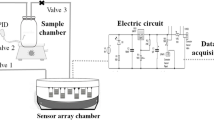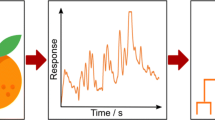Abstract
An array of filter paper based disposable sensors was developed for identification of orange juice adulteration. Small strips of Whatman filter papers (5 mm × 6 mm) were coated with conducting polymers i.e., polyaniline and polypyrrole (both in chloride doped and de-doped form) to develop the sensors. Silver electrodes were deposited on the polymer-coated sensor substrate using conducting silver paste. The sensors were exposed to various adulterations of orange juice with water dilution and sucrose addition. Impedance measurements from the sensor were monitored over a frequency range of 0.01–10 kHz using a Frequency Response Analyzer. The adulteration of fresh orange juice using water dilution could be detected in the range of 1–30% by volume (in steps of ~ 5–10%) with minimum detection of 1% whereas sucrose (30% w/w) addition was successfully identified from 10 to 60% by volume (in steps of ~ 10%) with minimum detection of 10%. Owing to the non-specific response of the sensors, statistical analysis using Principal Component Analysis, Linear Discriminant Analysis, t-Distributed Stochastic Neighbor Embedding, and k-Means clustering algorithm were utilized to identify the trend in the impedance response shift for various levels of adulterations in orange juice. Among the different classification methods, LDA provided the best results in differentiating between different levels of adulterations followed by k-Means clustering algorithm. The developed sensor is a proof-of-concept for development of disposable electronic tongue with potential applications in beverage quality monitoring.








Similar content being viewed by others
Data availability
Not applicable.
References
M. Roy, B.K. Yadav, Electronic nose for detection of food adulteration: a review. J. Food Sci. Technol. 59, 846–858 (2022)
A.A. Arrieta, P.L. Arrieta, J.M. Mendoza, Analysis of coffee adulterated with roasted corn and roasted soybean using voltammetric electronic tongue. Acta Sci. Pol. Technol. Aliment. 18, 35–41 (2019)
E.W. Nery, L.T. Kubota, Integrated, paper-based potentiometric electronic tongue for the analysis of beer and wine. Anal. Chim. Acta 918, 60–68 (2016)
W. Novakowski, M. Bertotti, T.R.L.C. Paixão, Use of copper and gold electrodes as sensitive elements for fabrication of an electronic tongue: discrimination of wines and whiskies. Microchem. J. 99, 145–151 (2011)
E.I. Geană, C.T. Ciucure, V. Artem, C. Apetrei, Wine varietal discrimination and classification using a voltammetric sensor array based on modified screen-printed electrodes in conjunction with chemometric analysis. Microchem. J. 159, Article 105451 (2020)
C. Garcia-Hernandez, C. Salvo Comino, F. Martín-Pedrosa, M.L. Rodriguez-Mendez, C. Garcia-Cabezon, Impedimetric electronic tongue based on nanocomposites for the analysis of red wines. Improving the variable selection method. Sens. Actuators B Chem. 277, 365–372 (2018)
X. Cetó, J. Capdevila, A. Puig-Pujol, M. del Valle, Cava wine authentication employing a voltammetric electronic tongue. Electroanalysis 26, 1504–1512 (2014)
C.A. Blanco, R. de la Fuente, I. Caballero, M.L. Rodríguez-Méndez, Beer discrimination using a portable electronic tongue based on screen-printed electrodes. J. Food Eng. 157, 57–62 (2015)
Y.S. Mutz et al., Portable electronic tongue based on screen-printed electrodes coupled with chemometrics for rapid differentiation of Brazilian lager beer. Food Control 127, 108163 (2021)
T.N. Kulikova et al., Discrimination of tea by the electrochemical determination of its antioxidant properties by a polyaniline–DNA–polyphenazine dye modified glassy carbon electrode. Anal. Lett. 52, 2562–2582 (2019)
T.C.B. de Morais, D.R. Rodrigues, U.T. de Carvalho Polari Souto, S.G. Lemos, A simple voltammetric electronic tongue for the analysis of coffee adulterations. Food Chem. 273, 31–38 (2019)
Z. Wei, J. Wang, X. Zhang, Monitoring of quality and storage time of unsealed pasteurized milk by voltammetric electronic tongue. Electrochim. Acta 88, 231–239 (2013)
L. Bueno, W.R. de Araujo, M.O. Salles, M.Y. Kussuda, T.R.L.C. Paixão, Voltammetric electronic tongue for discrimination of milk adulterated with urea, formaldehyde and melamine. Chemosensors 2, 251–266 (2014)
I. Tazi, K. Triyana, D. Siswanta, A.C.A. Veloso, A.M. Peres, L.G. Dias, Dairy products discrimination according to the milk type using an electrochemical multisensor device coupled with chemometric tools. J. Food Meas. Charact. 12(4), 2385–2393 (2018)
C. Salvo-Comino, C. García-Hernández, C. García-Cabezón, M.L. Rodríguez-Méndez, Discrimination of milks with a multisensor system based on layer-by-layer films. Sensors 18(8), 2716 (2018)
Z. Ma et al., Design and application of electronic tongue system for orange juice quality detection using internet of things. IFAC-PapersOnLine 51(17), 437–442 (2018)
L. Sobrino-Gregorio, R. Bataller, J. Soto, I. Escriche, Monitoring honey adulteration with sugar syrups using an automatic pulse voltammetric electronic tongue. Food Control 91, 254–260 (2018)
A. Lotfi, Z. Izadi, M. Ghasemi-Varnamkhasti, Implementation of a portable electronic tongue system for detection of sodium benzoate adulteration in tomato paste. Innov. Food Technol. 8(2), 295–308 (2021)
F. Vitalis et al., Detection and quantification of tomato paste adulteration using conventional and rapid analytical methods. Sensors 20(1), 6059 (2020)
F. Shen, Q. Wu, A. Su, P. Tang, X. Shao, B. Liu, Detection of adulteration in freshly squeezed orange juice by electronic nose and infrared spectroscopy. Czech J. Food Sci. 34, 224–232 (2016)
A. Riul Jr. et al., Wine classification by taste sensors made from ultra-thin films and using neural networks. Sens. Actuators B Chem. 98, 77–82 (2004)
L. Lu, Z. Hu, X. Hu, D. Li, S. Tian, Electronic tongue and electronic nose for food quality and safety. Food Res. Int. 162(1), 112214 (2022)
S. Pirsa, N. Alizadeh, Rapid determination of pyridine derivatives by dispersive liquid-liquid microextraction coupled with gas chromatography/gas sensor based on nanostructured conducting polypyrrole. Talanta 87, 249–254 (2011)
S. Pirsa, N. Alizadeh, Nanoporous conducting polypyrrole gas sensor coupled to a gas chromatograph for determination of aromatic hydrocarbons using dispersive liquid-liquid microextraction method. IEEE Sens. J. 11(12), 3400–3405 (2011)
N. Alizadeh, S. Pirsa, A. Mani-Varnosfaderani, M.S. Alizadeh, Design and fabrication of open-tubular array gas sensors based on conducting polypyrrole modified with crown ethers for simultaneous determination of alkylamines. IEEE Sens. J. 15(7), 4130–4136 (2015)
S. Pirsa, H. Heidari, J. Lotfi, Design selective gas sensors based on nano-sized polypyrrole/polytetrafluoroethylene and polypropylene membranes. IEEE Sens. J. 16(9), 2922–2928 (2016)
N. Alizadeh, A.A. Ataei, S. Pirsa, Nanostructured conducting polypyrrole film prepared by chemical vapor deposition on the interdigital electrodes at room temperature under atmospheric condition and its application as gas sensor. J. Iran. Chem. Soc. 12, 1585–1594 (2015)
A. Saidfar, M. Alizadeh, S. Pirsa, Application of nano-sized poly N-phenyl pyrrole coated polyester fiber to headspace microextraction of some volatile organic compounds and analysis by gas chromatography. Curr. Anal. Chem. 12(5), 457–464 (2020)
M. Alizadeh, S. Pirsa, N. Faraji, Determination of lemon juice adulteration by analysis of gas chromatography profile of volatile organic compounds extracted with nano-sized polyester-polyaniline fiber. Food Anal. Methods 10, 2092–2101 (2017)
S. Pirsa, F.M. Nejad, Simultaneous analysis of some volatile compounds in food samples by array gas sensors based on polypyrrole nano-composites. Sens. Rev. 37(2), 155–164 (2017)
M.A. Sheikh-Mohseni, S. Pirsa, Nanostructured conducting polymer/copper oxide as a modifier for fabrication of l-DOPA and uric acid electrochemical sensor. Electroanalysis 28(9), 2075–2080 (2016)
S. Pirsa, A. Afshar Asl, A. Khani, A. Allahverdi Pur, Fabrication of 1, 1-dimethylhydrazine gas sensor based on nano structure conducting polyaniline. J. Sci. Islam. Repub. Iran 24(3), 209–215 (2013)
C.M. Daikuzono et al., Paper based electronic tongue—a low-cost solution for the distinction of sugar type and apple juice brand. Analyst 144, 2827–2832 (2019)
K.L. Fukushima et al., Development of an electronic tongue based on a nanocomposite for discriminating flavor enhancers and commercial salts. IEEE Sens. J. 21, 1250–1256 (2021)
P.W. Ruch, et al., A portable potentiometric electronic tongue leveraging smartphone and cloud platforms, in ISOEN 2019 - 18th Int. Symp. Olfaction Electron. Nose SAVE Proc. (2019)
R.A.G. Rañola, K.S. Santiago, F.B. Sevilla, Use of array of conducting polymers for differentiation of coconut oil products. Talanta 146, 75–82 (2016)
D. Mondal, D. Paul, S. Mukherji, Impedance spectroscopy-based detection of cardiac biomarkers on polyaniline coated filter paper. IEEE Sens. J. 17(16), 5021–5029 (2017)
C. Dhand, M. Das, M. Datta, B.D. Malhotra, Recent advances in polyaniline based biosensors. Biosens. Bioelectron. 26, 2811–2821 (2011)
T.-H. Le, Y. Kim, H. Yoon, Electrical and electrochemical properties of conducting polymers. Polymers 9, 150 (2017)
D. Mondal, D. Paul, S. Mukherji, Conducting polymer coated filter paper based disposable electronic tongue, in 2018 12th International Conference on Sensing Technology (ICST), Limerick, Ireland, pp. 7–12 (2018)
W. Lyu, B. Yuan, S. Liu, J.E. Simon, Q. Wu, Assessment of lemon juice quality and adulteration by ultra-high performance liquid chromatography/triple quadrupole mass spectrometry with interactive and interpretable machine learning. J. Food Drug Anal. 29(2), 275–286 (2021)
M. Bizzani, D.W.M. Flores, L.A. Colnago, M.D. Ferreira, Monitoring of soluble pectin content in orange juice by means of MIR and TD-NMR spectroscopy combined with machine learning. Food Chem. 332, 127383 (2020)
S. Yeganeh-Zare, K. Farhadi, S. Amiri, Rapid detection of apple juice concentrate adulteration with date concentrate, fructose and glucose syrup using HPLC-RID incorporated with chemometric tools. Food Chem. 370, 131015 (2022)
M. Varnasseri, Y. Xu, R. Goodacre, Rapid detection and quantification of the adulteration of orange juice with grapefruit juice using handheld Raman spectroscopy and multivariate analysis. Anal. Methods 14, 1663 (2022)
J.L.P. Calle et al., Rapid detection and quantification of adulterants in fruit juices using machine learning tools and spectroscopy data. Sensors 22, 3852 (2022)
F. Vitalis et al., Detection and quantification of tomato paste adulteration using conventional and rapid analytical methods. Sensors 20, 6059 (2020)
F. Vitalis et al., Detection of Monilia contamination in plum and plum juice with NIR spectroscopy and electronic tongue. Chemosensors 9, 355 (2021)
G. Bahrami, M.H. Aghkhani, M.R. Golzarian, B. Deiminiat, The comparison of cyclic voltammetry and electronic tongue methods in the diagnosis of lime juice adulteration. J. Agric. Mach. (2023). https://doi.org/10.22067/jam.2023.83040.1173
T. Yin et al., Development of a remote electronic tongue system combined with the VMD-HT feature extraction method for honey botanical origin authentication. Measurement 171, 108555 (2021)
Acknowledgements
The authors are thankful to the Department of Biosciences and Bioengineering, Indian Institute of Technology Bombay for providing the facilities to carry out the experimental work.
Author information
Authors and Affiliations
Contributions
Conceptualization: Debasmita Mondal; Methodology: Debasmita Mondal; Formal analysis and investigation: Debasmita Mondal, Md. Zeeshan Equbal, Akshat Jain and Vaibhav Mishra; Writing—original draft preparation: Debasmita Mondal, Md. Zeeshan Equbal, Akshat Jain and Vaibhav Mishra; Writing—review and editing: Debasmita Mondal, Md. Zeeshan Equbal, Akshat Jain and Vaibhav Mishra.
Corresponding author
Ethics declarations
Competing interests
The authors have no competing interests to declare that are relevant to the content of this article.
Additional information
Publisher's Note
Springer Nature remains neutral with regard to jurisdictional claims in published maps and institutional affiliations.
Rights and permissions
Springer Nature or its licensor (e.g. a society or other partner) holds exclusive rights to this article under a publishing agreement with the author(s) or other rightsholder(s); author self-archiving of the accepted manuscript version of this article is solely governed by the terms of such publishing agreement and applicable law.
About this article
Cite this article
Mondal, D., Equbal, M.Z., Jain, A. et al. Disposable paper-based sensor array for detection of orange juice adulteration. Food Measure (2024). https://doi.org/10.1007/s11694-024-02608-5
Received:
Accepted:
Published:
DOI: https://doi.org/10.1007/s11694-024-02608-5




